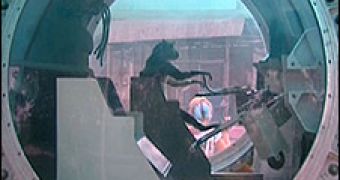Laika preceded the first manned spaceflight; why can't macaques preceed the first manned flight to Mars? According to Russian scientists, they can and they will. The first living being to the Martian system will most likely be a monkey, not a man. The reason is very simple and easy to guess; radiation poses too great of a risk for human astronauts to be sent into long space missions, such as a manned mission to the Red Planet.
"People and monkeys have approximately identical sensitivity to small and large radiation doses. So it is better to experiment on the macaques, but not on dogs or other animals," says Boris Lapin, Sochi Institute of Medical Primatology director.
The institute will conduct a series of studies in order to select the macaques that will mostly likely be sent to Mars. Once the two years of study are completed, the Institute of Biomedical Problem will receive 40 monkeys for further investigation. Alternatively, the Russian Space Agency will run a project known as Mars-500; volunteers will be have to spend 17 months in a spacecraft mockup while simulating the conditions experienced during interplanetary flight.
Mars-500
Radiation poisoning is just one of the multiple concerns expressed by scientists while considering a long space journey. Weightlessness, isolation and the food diet will also be the subject of study during the monkey experiments.
"About 520 days would be required during a light to Mars - 250 days to fly there, 250 days to come back and a month for the landing on Mars," said Viktor Baranov, Mars-500 project director.
"Humanity sacrifices more than 100 million animals a year in the name of heath and beauty. It's time to think of an alternative to experiments with animals. I'm sure scientists will repeat the story of Laika, the first dog in space. Today it's no secret that the dog died from the nervous stress immediately after the rocket launch and its dead body revolved in orbit for two weeks," says Andrei Zbarsky of the international nature conservation group WWF, while expressing his concern regarding the use of animals in scientific experiments.
Krosh
The macaques used by the institute are bred in captivity, thus it is not necessary to capture them in the wild. Previously, twelve macaques have flown into space with the help of Russian or Soviet spacecrafts. The first such spaceflight occurred in December 1983, when two monkeys named Abrek and Bion spent five days into space. In 1985, Verny and Gordy remained in orbit around Earth for seven days. Another two monkeys were carried into space two years later, with Dryoma being presented to the Cuban dictator Fidel Castro.
Three other missions carrying monkeys into space were launched in 1989, 1992 and 1996, afterwards the program being ended because Russia had no more monkeys. The oldest monkey that was flown into space and is still alive is the 16-year-old Krosh.
"Old man Krosh is about 60 years old, if we translate his monkey age to a human life span. He is very active. He responds well to food and is aggressive with his female partners. After rehabilitation he produced offspring. And that's proof that spaceflight did not harm his health," said Anaida Shaginyan, researcher for the institute.

 14 DAY TRIAL //
14 DAY TRIAL //